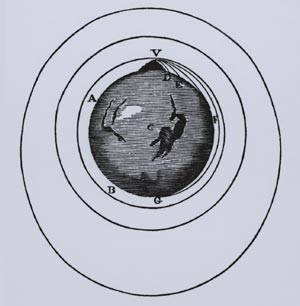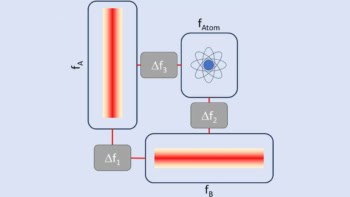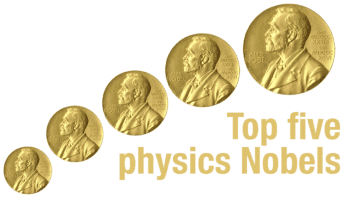Newton's famous equation describing the gravitational force between two objects altered more than our ideas of the solar system. As Robert P Crease explains, it also influenced our conception of human nature

In his 1728 book A Treatise of the System of the World, Isaac Newton described what would happen if one shot a stone horizontally from the peak of a mountain that poked above the atmosphere. The more forcefully the stone is shot, he reasoned, the further around the Earth it will travel. If shot with sufficient strength, however, the stone will return to the peak, and “retaining the same velocity, it will describe the same curve over and over, by the same law”.
Thus Newton illustrated the principle of an orbit, which not only accounts for the paths of objects in the solar system but also explains the trajectories of the thousands of satellites and spacecraft that have been launched since Sputnik 1 blasted off half a century ago this month (see “Sputnik’s legacy”). Underpinning this principle is, of course, Newton’s inverse-square law of gravitation.
Impact on science
Historians of science have closely traced the path to this law, which began in about 1600 when Johannes Kepler described a force — extending from the Sun to the planets — that weakened in proportion to distance. His idea was mocked by the French astronomer Ismael Boulliau, who in 1645 said that such a force would have to radiate in all directions like light and so would weaken with the square of the distance. Boulliau simply found it impossible to believe God would act this way. Others did think that an inverse-square law was likely, but saw it as the natural outcome of a tug of war between a centre-fleeing, centrifugal force and a centre-seeking force.
In January 1684, in a London coffee house, the architect and astronomer Christopher Wren challenged his comrades Edmund Halley and Robert Hooke to demonstrate — within two months — the validity of the inverse-square law for planetary motion. Neither could, but Halley approached Newton with the problem. By December 1684 Newton had realized that as a consequence of his third law of motion, the planets must pull back on the Sun — and on each other — and that they all revolve about a common centre of gravity.
This seminal insight of universal gravitation was to inaugurate one of the most profound transformations in Western science. Indeed, it led to Newton becoming the “gold standard” against which scholars in other sciences compared the superstars in their fields. James Clerk Maxwell, for example, hailed Ampère as the Newton of electricity, while Alfred R Wallace, Thomas Huxley and others called Darwin the Newton of biology.
Moreover, Newton’s law of gravitation was often cited as the kind of law that a science required. François Magendie, in his 1817 textbook entitled Elementary Sketch of Physiology, lamented the absence from his field of “an intellect of the first order to come and discover the laws of the vital force in the same way Newton made known the laws of attraction”.
Impact outside science
The influence of Newton’s law of gravitation extended well beyond science, however – to education, philosophy, theology and other areas of human culture. It also changed the very notion of “law”.
In modern times, the concept of a scientific law has a specific meaning. For example, in his book The Software of the Universe: An Introduction to the History and Philosophy of Laws of Nature, the philosopher Mauro Dorato from the University of Rome 3 calls a scientific law “a mathematical relationship between properties of physical systems”.
For the ancient Greeks, however, a law was an order that a ruler gave to subjects. Non-human nature was different. It was a kind of cosmic ecosystem containing many different levels of organization and underpinned by a complex network of overlapping causes, which could not be explained in a simple way.
Even as late as the 17th century, many scientists refused to apply the term law to regularities in nature, insisting that it was no more than a metaphorical extension of social language to the natural world. But the growing appreciation for the clockwork-like structure of the cosmos inclined others, such as Descartes, to describe creation as a juridical act by a supreme law-giver. Newton’s law of gravitation — universal in scope — gave an enormous boost to this inclination. The influence had now been reversed: natural language was extended to the social world.
Many political theorists even used Newtonian language — so much so that it actually influenced the modern conception of democracy, as the late historian I Bernard Cohen makes clear in his 1995 book Science and the Founding Fathers: Science in the Political Thought of Thomas Jefferson, Benjamin Franklin, John Adams, and James Madison.
Even the birth of socialism is tied up with Newton’s law. For the French political thinker Henri de Saint-Simon (1760–1825), who was one of the founders of socialism, Newton’s law showed the way to a scientific approach to social life, based on universal fraternity and collective organization. Saint- Simon had a vision in which God disclosed to him that Newton sat at his right hand and decreed that the world should be governed by a committee called the “council of Newton”. Its primary task — Saint-Simon is quoting God now — was to discover “a new law of gravitation applicable to social bodies”.
To be sure, Saint-Simon was a flamboyant character, and the kind of megalomaniac aristocrat — idealist, bad writer, idiot and eccentric — with which early 19th-century socialism was amply stocked. But he was not alone. Other political thinkers, including Pierre Cabanis, Charles Fourier and Giovanni Morelli, tried to apply the notion of gravitational attraction to human life in holding that free, subjective, conscious individuals were nonetheless compelled by universal, deterministic scientific law — a notion that also influenced Karl Marx.
The critical point
Newton’s law of gravitation did more than quantify the attraction between objects, be they pebbles or spacecraft. Among other things, the law inspired scholars in other fields to seek descriptive, mathematical and universal laws. In so doing, it not only altered our understanding of nature, but also our conception of science and of human life.



